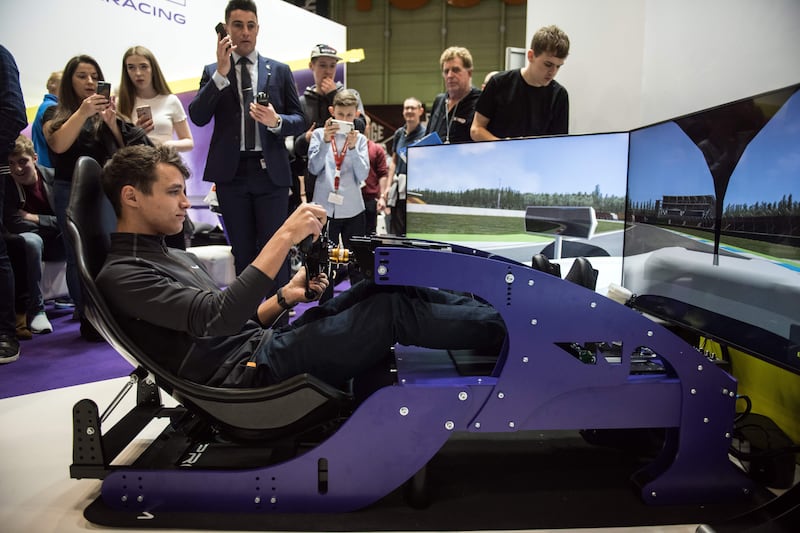In 2020, e-racing exploded. That was hardly a surprise. As we entered our first lockdown, international motor racing was brought to halt. With the technology to simulate a racing car and its environs increasingly available through commercial channels, sports enthusiasts quickly turned to binary code to get their racing fix.
It wasn’t just computer geeks in dusty basements who got in on the e-racing and esports action. A quartet of famous Formula One drivers – Charles Leclerc, Lando Norris, George Russell and Alex Albon – became almost as renowned for their digital racing exploits, and their cheery chit-chat at the wheel, as they were for driving a real F1 car. Even Max Verstappen jumped aboard, competing online in international events such as the Virtual Le Mans 24 hrs.
The pandemic had an unexpected knock-on effect on one of the more obscure areas of global motorsports, pushing what had been a low-key hobby into the forefront of the racing industry.
Zooming into pole position is an Irish company, Digital Motorsports. Based at Mondello Park in Co Kildare, an actual, physical racetrack, Digital’s simulators are in a suite overlooking a genuine pitlane. It’s a slightly odd experience to be plugged into a simulation of the track at Mondello while actual cars blast by on the pit straight outside.
Rob King was instrumental in getting Digital Motorsports to where it is – a place where it’s successful enough to have been just acquired by Canadian investors ESE Entertainment – and is now starting to look beyond the conventional.
Chatting to King, it’s clear that motor racing simulations have moved beyond simple fun. “One of the most exciting areas of the industry, commercially, is the untapped potential. It’s not being fully utilised yet as a driver training tool, for instance.”
In this, King isn’t talking about training racing drivers in the nuances of cornering lines – although the tech can do exactly that, too – but he’s thinking about actual road-safety training. “There are tens of thousands of new drivers in the UK and Ireland ever year,” says King. “And the vast majority of them would be very nervous when they’re driving in a car for the first time. So why not give them a few hours, or even a week’s course, in a simulator before they step into a real car? Just to give them that extra confidence.”
While King admits that there will always be a gap between simulation and the real world, he says that the tech can still be hugely helpful.
“We’ve done events with the likes of the ESB, for example. They all drove down to Mondello in their vans – Transits, Land Rovers, what have you – and we put them into the sims, and gave them a representation of a country road to drive along. It was set during the daytime, and with nice simulated weather and all that. But then we turned around and changed it to night time, we added in some rain, we messed around with the tyre pressures, we added weight to the vehicles, and we even added in some distraction such as playing music or even having us talk to the guys who were driving. Getting them to drive the same stretch of digital road in those conditions, the differences were astounding, and you can really learn useful stuff from that.”
The next step is to start reducing the gap in perception between the digital and the real world, working out how to mimic the g-forces and movements of a vehicle and further tricking the human brain into thinking that the simulation is the real thing. Such things can be done without recourse to vast hydraulic rigs and physical movement. There are aircraft simulators fixed to the ground, but whose simulation of control weights and clarity of screen projection is such that when the sim is switched on, you suddenly believe that there’s 200-tonnes of 737 on the other end of the stick you’re holding. Equally, F1 teams currently spend more time with their drivers wrangling simulated racing cars in digital environments than they do actually running real cars around a track. The sims have become so real that they can actually be used to work out if a new aerodynamic package is going to work better, or if a different tyre compound can make a difference to a car’s lap time.

That same tech could soon make the leap to the consumer world. Formula One has already demonstrated that it wants to bring the fans closer to the sport, but actually putting them behind the wheel in racing sessions is the next step. “In F1, there’s nothing to stop you racing, in a simulator, on the same track as George [Russell] and Lewis [Hamilton], while the live session is going on at the real track. You could be racing them in real-time. That could happen now, the technology already exists.”
There are fringe benefits to simulator use. Digital Motorsports has found that its technology can be helpful to people with autism. “We have simulators with 12 of the Rehab National Learning Network centres around the country,” says King. “They’re using them for lots of different use cases, including just being a reward to those who’ve put in a big effort, or helping people going for their driving tests. But one of the things they’ve found is that people with autism, not everyone maybe but certainly some, can get a huge benefit. If people are getting into a heightened or an anxious state, a half-hour in the simulator has worked better than anything in getting them back down again. Whether it’s that repetitive focus of driving the car, or having the input and involvement that helps, we’re not sure but it’s a very interesting development.”
[ Driving test waiting times over 30 weeks for learners in six centresOpens in new window ]
Back in the business world, Digital Motorsports has ambitious plans. Sean McGinley, another director of the company, said: “We were out of the gates pretty early in the esports boom, but now the market has become kind of saturated, certainly from an equipment supply point of view. So we’re looking to keep driving the industry, and to try to be number one at something new. Thanks to the ESE acquisition, that’s going to help us hit the refresh button and I think that the events side of things is going to be a really exciting space to be in.”
Recently, Digital Motorsports helped to run an event for Charles Hurst Ferrari in Belfast, where people who made a charitable donation could use one of the simulators to set lap-times in a simulated Ferrari racing car. That’s working with the most storied brand in racing, but it’s still at the smaller end of what’s possible.
At the other end? Massive esports gatherings, such as Gamers8 held in Riyadh, Saudi Arabia, which saw 50,000 people attend an arena-sized event with a prize pool of more than $40 million (€36.5 million). “We’re now in a position to build on our infrastructure and start making the sorts of propositions that say we can roll with the top guys” says McGinley.
The thing is that simulation, although not cheap – a very basic simulator, one at the point where you leave gaming behind and move into proper simulation, costs around €5,000 and you can easily spend six figures if you really want to – can save you money. Running a racing car is wildly more expensive, so using a simulator to log valuable practice time and actually benefit young drivers, especially young Irish drivers who often struggle to access the sort of sponsorship cash that’s available elsewhere.
“It’s a great pathway for those who can’t necessarily afford those extra days of testing. The cost of fuel, and tyres, and travel alone is prohibitive. The proof is in the pudding – professional race teams all over the world are using sims now,” says McGinley.
[ Formula One Grand Prix proposed for Dublin in 1992 never got over starting lineOpens in new window ]
Alex Dunne from Offaly is currently racing in the Italian Formula4 championship while Alex Denning, who is from Rathfarnham in Dublin and was chosen as Motorsport Ireland’s Young Driver of the Year last year, has just signed for the Aston Martin factory team.
“It’s just an essential part of the drivers’ training regime now,” says King. “So there are very few drivers even at club level in Ireland now who don’t have simulators.”








